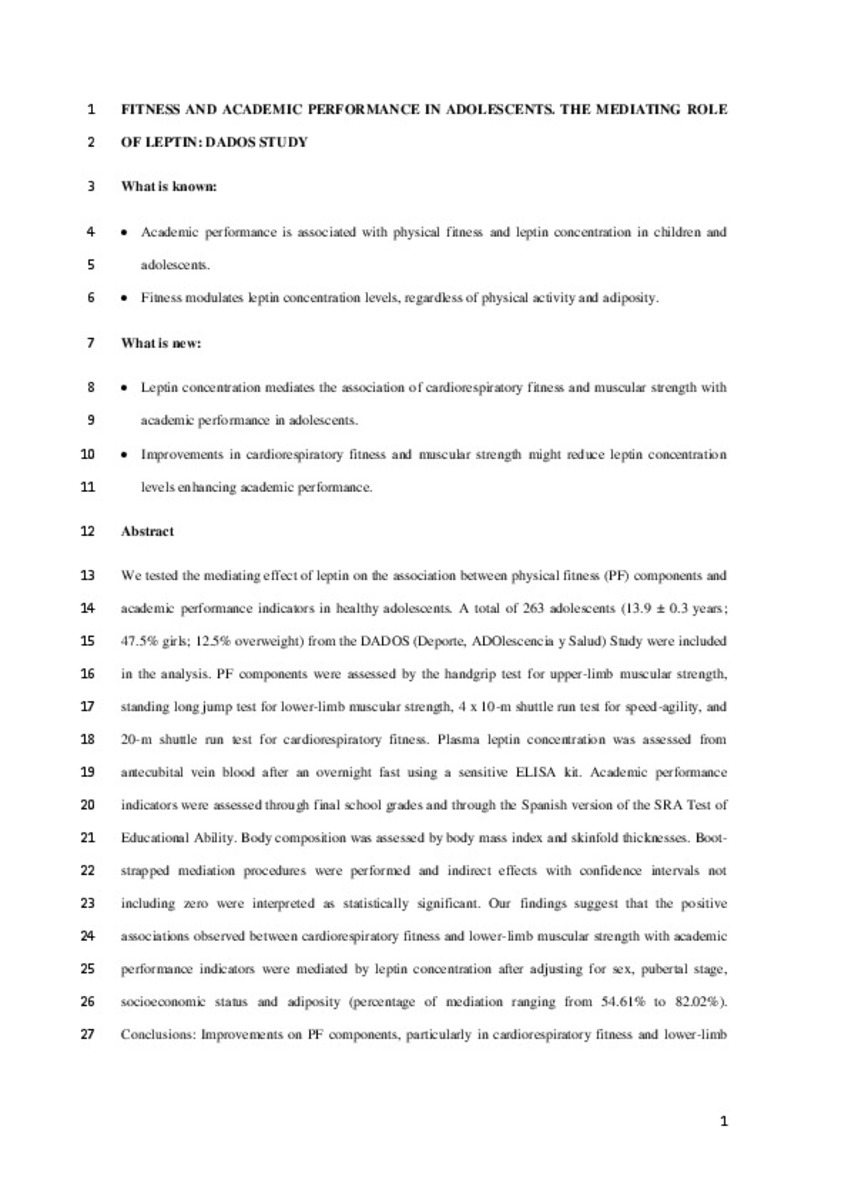| dc.contributor.author | Adelantado-Renau, Mireia | |
| dc.contributor.author | Jiménez Pavón, David | |
| dc.contributor.author | Beltran Valls, Maria Reyes | |
| dc.contributor.author | Ponce González, Jesús Gustavo | |
| dc.contributor.author | Chiva-Bartoll, Oscar | |
| dc.contributor.author | Moliner-Urdiales, Diego | |
| dc.date.accessioned | 2018-10-22T11:16:38Z | |
| dc.date.available | 2018-10-22T11:16:38Z | |
| dc.date.issued | 2018-07-25 | |
| dc.identifier.citation | ADELANTADO-RENAU, Mireia; JIMÉNEZ PAVÓN, David; BELTRAN VALLS, Maria Reyes; PONCE GONZÁLEZ, Jesús Gustavo; CHIVA BARTOLL, Òscar; MOLINER-URDIALES, Diego (2018). Fitness and academic performance in adolescents. The mediating role of leptin: DADOS study. European Journal of Pediatrics, v. 177, issue 10, p. 1555-1563 | ca_CA |
| dc.identifier.uri | http://hdl.handle.net/10234/176893 | |
| dc.description.abstract | We tested the mediating effect of leptin on the association between physical fitness (PF) components and academic performance indicators in healthy adolescents. A total of 263 adolescents (13.9 ± 0.3 years, 47.5% girls, 12.5% overweight) from the DADOS (Deporte, ADOlescencia y Salud) Study were included in the analysis. PF components were assessed by the handgrip test for upper-limb muscular strength, standing long jump test for lower-limb muscular strength, 4 × 10-m shuttle run test for speed-agility, and 20-m shuttle run test for cardiorespiratory fitness. Plasma leptin concentration was assessed from antecubital vein blood after an overnight fast using a sensitive ELISA kit. Academic performance indicators were assessed through final school grades and through the Spanish version of the SRA Test of Educational Ability. Body composition was assessed by body mass index and skinfold thicknesses. Boot-strapped mediation procedures were performed and indirect effects with confidence intervals not including zero were interpreted as statistically significant. Our findings suggest that the positive associations observed between cardiorespiratory fitness and lower-limb muscular strength with academic performance indicators were mediated by leptin concentration after adjusting for sex, pubertal stage, socioeconomic status, and adiposity (percentage of mediation ranging from 54.61 to 82.02%). Conclusions: Improvements on PF components, particularly in cardiorespiratory fitness and lower-limb muscular strength, might reduce leptin concentration with potential benefits on academic performance in adolescents, independently of adiposity. | ca_CA |
| dc.format.extent | 20 p. | ca_CA |
| dc.format.mimetype | application/pdf | ca_CA |
| dc.language.iso | eng | ca_CA |
| dc.publisher | Springer | ca_CA |
| dc.relation.isPartOf | European Journal of Pediatrics (2018), v. 177, issue 10 | ca_CA |
| dc.rights.uri | http://rightsstatements.org/vocab/CNE/1.0/ | * |
| dc.subject | Cognition | ca_CA |
| dc.subject | Health | ca_CA |
| dc.subject | School grades | ca_CA |
| dc.subject | Adolescence | ca_CA |
| dc.subject | Leptin | ca_CA |
| dc.title | Fitness and academic performance in adolescents. The mediating role of leptin: DADOS study. | ca_CA |
| dc.type | info:eu-repo/semantics/article | ca_CA |
| dc.identifier.doi | https://doi.org/10.1007/s00431-018-3213-z | |
| dc.relation.projectID | 1) Spanish Ministry of Economy and Competitiveness, MINECO (DEP2013-45515-R); 2) Jaume I University of Castellon, UJI (P1·1A2015-05); 3) Sunny Sport research grant from the Schweppes Suntory Spain Company; 4) Spanish Ministry of Science and Innovation-MINECO (RYC-2014–16938); 5) Predoctoral Research Grant from UJI (PREDOC/2015/13) | ca_CA |
| dc.rights.accessRights | info:eu-repo/semantics/openAccess | ca_CA |
| dc.relation.publisherVersion | https://link.springer.com/article/10.1007%2Fs00431-018-3213-z | ca_CA |
| dc.type.version | info:eu-repo/semantics/submittedVersion | ca_CA |







